Modeling and Simulation of Dissemination of Cultivated Land Protection Policies in China
Abstract
1. Introduction
2. Literature Review
2.1. Research Progress on CLPP
2.2. Research Progress of Public Policy Dissemination
3. Material and Methods
3.1. Scale-Free Network
3.2. CLPP Dissemination Model
4. Results and Analysis
4.1. Impact of FSN on CLPP
4.2. Numerical Simulation Experiment and Analysis
4.2.1. Impact of Immune Degradation Rate (Probably of Directly Changing from to ) on the Dissemination of CLPP
4.2.2. Impact of Vaccination Rate (Probably of Directly Changing from to ) on the Dissemination of CLPP
5. Conclusions and Policy Implications
- (1)
- The structural characteristics of the FSN have an important influence on the dissemination of CLPP. In the FSN, the greater initial dissemination rate of CLPP corresponds to larger scale and faster speed of CLPP dissemination. The time to reach the peak of dissemination is shorter, and the proportion of policy recipients is greater when the demonstration effect among farmers is more obvious. The CLPP dissemination rate in the FSN can be increased by increasing the total amount of farmers’ policy information and improving efficiency of media utilization. However, incomplete modern network infrastructure construction in some rural areas of China and the limited cultural level of farmers have resulted in the inefficient dissemination of CLPP (the habit of farmers to obtain policy information is still based on interpersonal dissemination).
- (2)
- A greater node degree of the FSN means shorter average path length between farmers and more structural holes occupied, which are highly conducive to the dissemination of CLPP. Most farmers in the process of dissemination of CLPP in China have problems such as incomprehension of the policy and inconsistent understanding. Therefore, an effective method for CLPP dissemination is to find farmers who act as opinion leaders in rural society (type-I structural holes) and fully utilize the influence of opinion leaders to promote the dissemination of CLPP. When the CLPP is disseminated in the FSN, the structural holes occupied by village cadres (type-II structural holes) should be eliminated, and the sharing of policy information among farmers outside the type-II structural holes should be realized.
- (3)
- The following observations are obtained from the numerical simulation results of the SEIRS model. On the one hand, higher immune degradation rate (agricultural subsidy policies) implies faster and wider dissemination of CLPP. Therefore, increasing the immune degradation rate can transform farmers into farmers as much as possible. This situation increases the dissemination of CLPP. On the other hand, the vaccination rate (the level of farmers’ perceived value) is an important factor in the dissemination of CLPP. Higher vaccination rate indicates shorter transition time from farmers to farmers and smaller range of the dissemination of CLPP.
- (1)
- Improving the policy dissemination rate. From the perspective of farmers, the dissemination of CLPP must be based on improving the knowledge of farmers. At this stage, problems such as limited education of farmers, poor adaptability to new media, and low media quality are the main obstacles affecting policy understanding. Therefore, the effective dissemination of farmland protection policies primarily considers the cultural level, level of policy acceptance, and habits of farmers. The local government should improve the re-education and training system centered on improving the quality of farmers to stimulate the initiative and enthusiasm of farmers’ policy needs. From the perspective of local governments, the dissemination channels for CLPP need to be diversified. Local governments need to establish a sound policy dissemination network, change the single dissemination channel, fully utilize modern dissemination technology, give full play to the role of new media, and enable the effective and rapid dissemination of CLPP.
- (2)
- Exerting the influence of opinion leaders (type-I structural holes) in FSN. The results of this study suggest that local governments should pay attention to cultivating farmers’ opinion leaders who have a higher education level, a larger SN, and are good at accepting new things to promote the dissemination of CLPP. First, the local government should strengthen the construction of the FSN to improve and strengthen the relationship between farmers, and the FSN with significant network structure characteristics should be formed to establish an effective platform for promoting the dissemination of CLPP. In addition, local governments must fully utilize the demonstration effect of opinion leaders. Specifically, local governments need to treat opinion leaders as first-level dissemination targets. This task requires not only to increase their awareness of the dissemination of CLPP, but also to improve their sense of responsibility, policy literacy, and policy ethics. Second-level dissemination through opinion leaders to surrounding farmers will eventually achieve the popularization of CLPP.
- (3)
- Weakening the influence of grassroots cadres in the FSN. First, local governments should promote the openness of the CLPP dissemination process. Local governments should initiate the production of a manual for the dissemination of CLPP. They should also announce specific measures such as the allocation of funds for agriculture preference policy to ensure the transparency of CLPP. Furthermore, obtaining the complete content of the CLPP is convenient for farmers. In addition, the quality of policy disseminators needs to be improved. Local governments should strengthen ideological and political education for policy disseminators, strengthen their interpretation of CLPP, and enable policy disseminators to devote themselves to the CLPP dissemination. Finally, a third-party supervision mechanism for the dissemination of CLPP should be constructed. Improving the supervision and feedback mechanism can effectively monitor and intervene in the process of policy dissemination. Accordingly, the effectiveness of the CLPP dissemination can be enhanced.
- (4)
- Improving the immune degradation rate (agricultural subsidies). China’s agricultural subsidy policy reform needs to start from three aspects: The amount of agricultural subsidies, the scope of agricultural subsidies, and the modes of agricultural subsidies. First, the amount of agricultural subsidies should be increased to mobilize the enthusiasm of farmers in production and ensure that grain production does not decline given that the comparative benefits of agricultural production are declining annually. Therefore, the total amount of agricultural subsidies should be continuously expanded in accordance with the principle that the increase in agricultural subsidies is significantly higher than the increases in fiscal expenditure and agricultural production costs. In addition, the scope and objects of agricultural subsidies need to be expanded, and agricultural subsidies should be promoted to tilt toward new agricultural business entities (family farms, farmer cooperatives, and large grain growers) and to protect the ecological environment (soil testing for fertilizer formulation). Finally, the various affecting factors of cultivated land protection behavior of farmers need to be analyzed, and agricultural subsidy funds should be arranged in a targeted manner. Differentiated agricultural subsidy policies need to be implemented, and the supervision of subsidy implementation should be strengthened to realize the optimization of agricultural subsidy modes. The abovementioned measures can promote the re-dissemination of CLPP.
- (5)
- Reducing the immunization rate (improving the perceived benefits of farmers). At present, the perception of economic value is still a key factor for farmers to protect their cultivated land. Therefore, local governments should actively promote land circulate and the development of agricultural socialized service systems to create favorable conditions for large-scale farmland management, increased grain production, improved agricultural efficiency, and enhanced farmers’ income [52]. This situation will increase farmers’ perception of economic value of cultivated land protection and lower the threshold for farmers to participate in cultivated land protection. Farmers’ perceptions of ecological and social values also play an important role in the decision-making process of whether to participate in cultivated land protection. Thus, the relevant departments should strengthen the popularization and publicity of environmental disasters in cultivated land production. Accordingly, farmers will have a comprehensive understanding of the environmental disaster risks faced in the process of cultivated land production and operation. The risk perception level of farmers needs to be improved and the concept of sustainable development of cultivated land for farmers should be established to improve their awareness of CLPP.
- (6)
- Build a dissemination system for CLPP in China. The construction of CLPP dissemination system now involves many policy information entities, including both the supplier and the demander of information. Therefore, the modern CLPP dissemination system should be led by government construction and management, with new farmers as the key dissemination media, and serving farmers as the fundamental goal. The central government has a large amount of useful agricultural information, and regularly releases statistical data, policies, regulations, and system construction to the agricultural sector through public services, which can promote the development of informatization of CLPP. In addition, county governments should be regarded as the main body of the disseminate of CLPP. County governments often cover all cultivated land protection information in a region. Therefore, the county government should be the main starting point of dissemination, which will help to form a standardized and effective CLPP information network and play a role in reducing the CLPP information asymmetry.
Author Contributions
Funding
Acknowledgments
Conflicts of Interest
References
- Jiang, G.; Wang, M.; Qu, Y.; Zhou, D.; Ma, W. Towards cultivated land multifunction assessment in China: Applying the “influencing factors-functions-products-demands” integrated framework. Land Use Policy 2020, 99, 104982. [Google Scholar] [CrossRef]
- Wang, Y.; Li, X.; He, H.; Xin, L.; Tan, M. How reliable are cultivated land assets as social security for Chinese farmers? Land Use Policy 2019, 90, 104318. [Google Scholar] [CrossRef]
- Jiang, L.; Deng, X.; Seto, K. Multi-level modeling of urban expansion and cultivated land conversion for urban hotspot counties in China. Landsc. Urban Plan. 2012, 108, 131–139. [Google Scholar] [CrossRef]
- Yu, Z.; Yao, L.; Wu, M. Farmers’ attitude towards the policy of remediation during fallow in soil fertility declining and heavy metal polluted area of China. Land Use Policy 2020, 97, 104741. [Google Scholar] [CrossRef]
- Qin, W.; Zhang, Y.; Li, G. Driving mechanism of cultivated land transition in Yantai Proper, Shandong Province, China. Chin. Geogr. Sci. 2014, 25, 337–349. [Google Scholar] [CrossRef]
- Wu, Y.; Shan, L.; Guo, Z.; Peng, Y. Cultivated land protection policies in China facing 2030: Dynamic balance system versus basic farmland zoning. Habitat Int. 2017, 69, 126–138. [Google Scholar] [CrossRef]
- Cheng, Q.; Jiang, P.; Cai, L.; Shan, J.; Zhang, Y.; Wang, L.; Li, M.; Li, F.; Zhu, A.; Chen, D. Delineation of a permanent basic farmland protection area around a city centre: Case study of Changzhou City, China. Land Use Policy 2017, 60, 73–89. [Google Scholar]
- Meng, X.; Lin, J. Reflections on Land Use Control Institutional System. China Popul. Resour. Environ. 2015, 25, 71–73. (In Chinese) [Google Scholar]
- Xie, H.; Cheng, L.; Lu, H. Farmers’ responses to the winter wheat fallow policy in the groundwater funnel area of China. Land Use Policy 2018, 73, 195–204. [Google Scholar] [CrossRef]
- Liu, X.; Zhao, C.; Song, W. Review of the evolution of cultivated land protection policies in the period following China’s reform and liberalization. Land Use Policy 2017, 67, 660–669. [Google Scholar] [CrossRef]
- Jianjun, J.; Chong, J.; Lun, L. The economic valuation of cultivated land protection: A contingent valuation study in Wenling City, China. Landsc. Urban Plan. 2013, 119, 158–164. [Google Scholar] [CrossRef]
- Saint-Macary, C.; Keil, A.; Zeller, M.; Heidhues, F.; Dung, P. Land titling policy and soil conservation in the northern uplands of Vietnam. Land Use Policy 2010, 27, 617–627. [Google Scholar] [CrossRef]
- Xie, H.; Zhang, Y.; Choi, Y. Measuring the Cultivated Land Use Efficiency of the Main Grain-Producing Areas in China under the Constraints of Carbon Emissions and Agricultural Nonpoint Source Pollution. Sustainability 2018, 10, 1932. [Google Scholar] [CrossRef]
- Yu, L.; Cai, Y. Performance Evaluation and Obstacle Indicator Diagnoses of Economic Compensation for Farmland Protection Policy Based on Farmers’ Satisfaction. J. Nat. Resour. 2015, 30, 1092–1103. (In Chinese) [Google Scholar]
- Liu, D.; Gong, Q.; Yang, W. The Evolution of Farmland Protection Policy and Optimization Path from 1978 to 2018. J. Soil Water Conserv. 2018, 408, 39–53. [Google Scholar]
- Monclar, R.; Tecla, A.; Oliveira, J.; de Souza, J. Using spatial–temporal information to improve social networks and knowledge dissemination. Inf. Sci. 2009, 179, 2524–2537. [Google Scholar] [CrossRef]
- Yin, J.; Shi, S. Analysis of the mediating role of social network embeddedness on low-carbon household behaviour: Evidence from China. J. Clean Prod. 2019, 234, 858–866. [Google Scholar] [CrossRef]
- Foster, A.; Rosenzweig, M. Learning by doing and learning from others: Human capital and technical change in agriculture. J. Polit. Econ. 1995, 103, 1176–1209. [Google Scholar] [CrossRef]
- Wang, P.; Tian, C.; Lu, J. Identifying influential spreaders in artificial complex networks. J. Syst. Sci. Complex. 2014, 27, 650–665. [Google Scholar] [CrossRef]
- Shi, Y.; Li, C.; Zhao, M. The impact of non-market value cognition and social capital on farmers’ willingness in farmland protection Cooperation. China Popul. Resour. Environ. 2019, 29, 94–103. (In Chinese) [Google Scholar]
- Patrick, F.; Bruning, B.; Alge, H. Social networks and social media: Understanding and managing influence vulnerability in a connected society. Bus. Horiz. 2020, 7, 7. [Google Scholar]
- Su, J.; Zhang, X.; Yang, J.; Qian, X. Modelling and simulating knowledge diffusion in knowledge collaboration organisations using improved cellular automata. J. Simul. 2018, 13, 181–194. [Google Scholar]
- Fu, M.; Feng, J.; Lande, D.; Dmytrenko, O.; Manko, D.; Prakapovich, R. Dynamic model with super spreaders and lurker users for preferential information propagation analysis. Physics A 2021, 561, 125266. [Google Scholar] [CrossRef]
- Yang, S.; Wang, L.; Zhang, J. Promotion Strategy of High-Carbon Industry’s Low-Carbon Transformation Power Based on SEIR Model. Sci. Technol. Manag. Res. 2019, 11, 261–268. [Google Scholar]
- Zhu, L.; Zhou, X.; Li, Y. Global dynamics analysis and control of a rumor spreading model in online social networks. Physics A 2019, 526, 120903. [Google Scholar] [CrossRef]
- Lv, X.; Huang, X.; Chen, Z.; Tang, J.; Zhao, Y. Evaluation on the Grain Production Performance of the Cultivated Land Protection Policy in China. Res. Sci. 2010, 32, 2343–2348. [Google Scholar]
- Cao, H.; Zhu, X.; Heijman, W.; Zhao, K. The impact of land transfer and farmers’ knowledge of farmland protection policy on pro-environmental agricultural practices: The case of straw return to fields in Ningxia, China. J. Clean Prod. 2020, 277, 123701. [Google Scholar] [CrossRef]
- Schiefer, J.; Lair, G.; Blum, W. Potential and limits of land and soil for sustainable intensification of European agriculture. Agric. Ecosyst. Environ. 2016, 230, 283–293. [Google Scholar] [CrossRef]
- Sokolow, A. Federal Policy for Preserving Farmland: The Farm and Ranch Lands Protection Program. J. Fed. 2010, 40, 235–256. [Google Scholar] [CrossRef]
- Marja, R.; Herzon, I.; Viik, E.; Elts, J.; Mänd, M.; Tscharntke, T.; Batáry, P. Environmentally friendly management as an intermediate strategy between organic and conventional agriculture to support biodiversity. Biol. Conserv. 2014, 178, 146–154. [Google Scholar] [CrossRef]
- Maggetti, M.; Gilardi, F. Problems (and solutions) in the measurement of policy diffusion mechanisms. J. Public Policy. 2015, 36, 87–107. [Google Scholar] [CrossRef]
- Septiono, W.; Kuipers, M.; Ng, N.; Kunst, A.E. Progress of smoke-free policy adoption at district level in Indonesia: A policy diffusion study. Int. J. Drug Policy. 2019, 71, 93–102. [Google Scholar] [CrossRef] [PubMed]
- Alizada, K. Rethinking the diffusion of renewable energy policies: A global assessment of feed-in tariffs and renewable portfolio standards. Energy Res. Soc. Sci. 2018, 44, 346–361. [Google Scholar] [CrossRef]
- Baldwin, E.; Carley, S.; Nicholson-Crotty, S. Why do countries emulate each others’ policies? A global study of renewable energy policy diffusion. World Dev. 2019, 120, 29–45. [Google Scholar] [CrossRef]
- Song, A.; Cohen, P.; Hanich, Q.; Morrison, T.; Andrew, N. Multi-scale policy diffusion and translation in Pacific Island coastal fisheries. Ocean Coast. Manag. 2019, 168, 139–149. [Google Scholar] [CrossRef]
- Alasuutari, P.; Kangas, A. The global spread of the concept of cultural policy. Poetics 2020, 82, 101455. [Google Scholar] [CrossRef]
- He, S.; Tang, S.; Wang, W. stochastic SIS model driven by random diffusion of air pollutants. Physics A 2019, 532, 121759. [Google Scholar] [CrossRef]
- Jing, Y.; Peiyu, L.; Xiaobing, T.; Wenfeng, L. Improved SIR Advertising Spreading Model and Its Effectiveness in Social Network. Procedia Comput. Sci. 2018, 129, 215–218. [Google Scholar] [CrossRef]
- Zhao, D.; Sun, J.; Tan, Y.; Wu, J.; Dou, Y. An extended SEIR model considering homepage effect for the information propagation of online social networks. Physics A 2018, 512, 1019–1031. [Google Scholar] [CrossRef]
- Albert, R.; Barabási, A.L. Statistical mechanics of complex networks. Rev. Mod. Phys. 2002, 74, 47–97. [Google Scholar] [CrossRef]
- Mao, G.; Zhang, N. Fast approximation of average shortest path length of directed BA networks. Physics A 2017, 466, 243–248. [Google Scholar] [CrossRef]
- Kermack, W.; Mckendrick, A. Contributions to the mathematical theory of epidemics. Bull. Math. Biol. 1991, 53, 33–55. [Google Scholar]
- Baguelin, M.; Medley, G.; Nightingale, E.; O’Reilly, K.; Rees, E.; Waterlow, N.; Wagner, M. Tooling-up for infectious disease transmission modelling. Epidemics 2020, 32, 100395. [Google Scholar] [CrossRef]
- Wang, Y.; Bilsborrow, R.; Zhang, Q.; Li, J.; Song, C. Effects of payment for ecosystem services and agricultural subsidy programs on rural household land use decisions in China: Synergy or trade-off? Land Use Policy 2019, 81, 785–801. [Google Scholar] [CrossRef]
- Zhang, Y.; Xie, H. Welfare Effect Evaluation of Land-Lost Farmers’ Households under Different Livelihood Asset Allocation. Land 2019, 8, 176. [Google Scholar] [CrossRef]
- Burt, R. Structural holes and good ideas. Am. J. Sociol. 2004, 110, 349–399. [Google Scholar] [CrossRef]
- Burt, R. The Network Structure of Social Capital. Res. Organ. Behave. 2000, 22, 345–423. [Google Scholar] [CrossRef]
- Grosser, T.J.; Obstfeld, D.; Choi, E.W.; Woehler, M.; Lopez-Kidwell, V.; Labianca, G.; Borgatti, S. A Sociopolitical Perspective on Employee Innovativeness and Job Performance: The Role of Political Skill and Network Structure. Organ Sci. 2018, 29, 612–632. [Google Scholar] [CrossRef]
- Lopez, R.A.; He, X.; De Falcis, E. What Drives China’s New Agricultural Subsidies? World Dev. 2017, 93, 279–292. [Google Scholar] [CrossRef]
- Li, M.; Wang, J.; Zhao, P.; Chen, K.; Wu, L. Factors affecting the willingness of agricultural green production from the perspective of farmers’ perceptions. Sci. Total Environ. 2020, 738, 140289. [Google Scholar] [CrossRef]
- Yu, L.; Cai, Y. Assessing the Effect of Economic Compensation for Farmland Protection Policy: An Empirical Research and Comparison of the Eastern and Western Regions of China. China Land Sci. 2014, 28, 16–23. (In Chinese) [Google Scholar]
- Kuang, B.; Lu, X.; Zhou, M.; Chen, D. Provincial cultivated land use efficiency in China: Empirical analysis based on the SBM-DEA model with carbon emissions considered. Technol. Forecast. Soc. Chang. 2020, 151, 119874. [Google Scholar] [CrossRef]
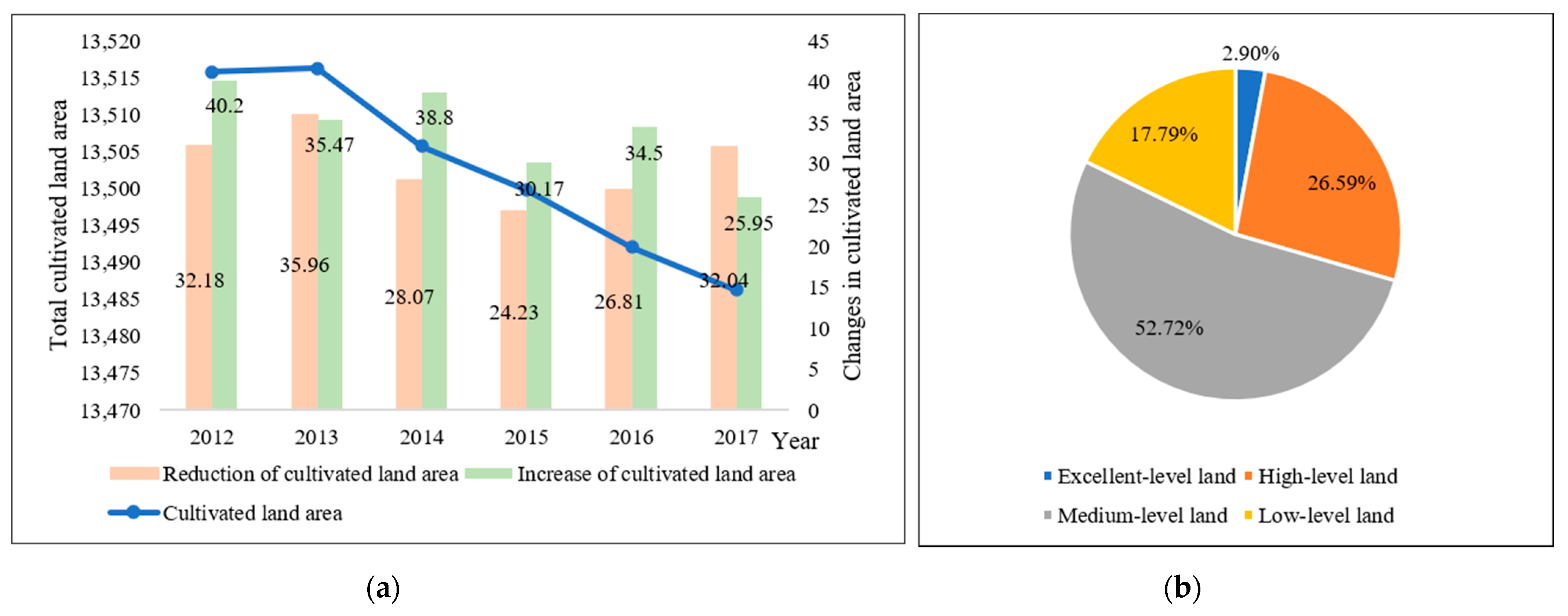
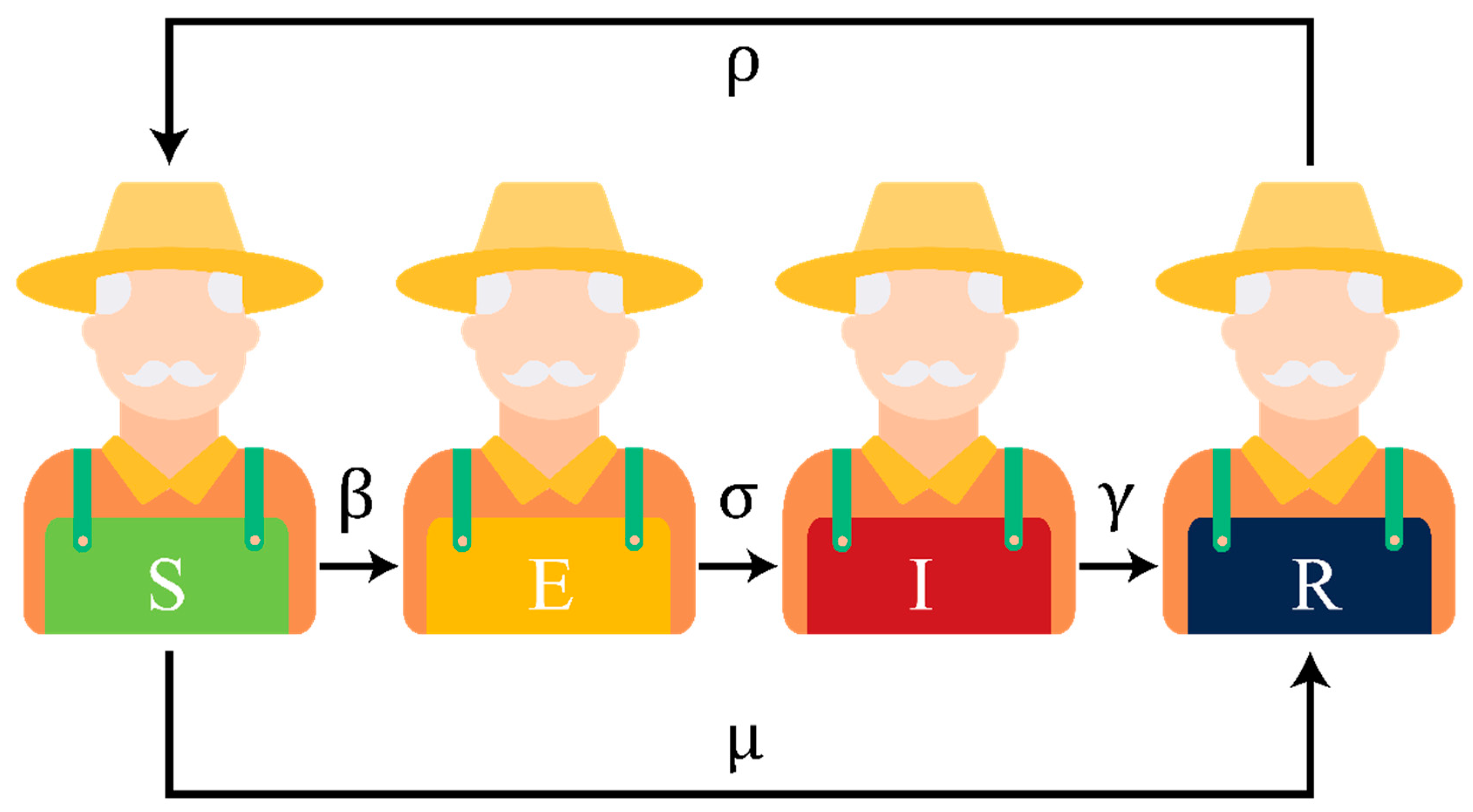

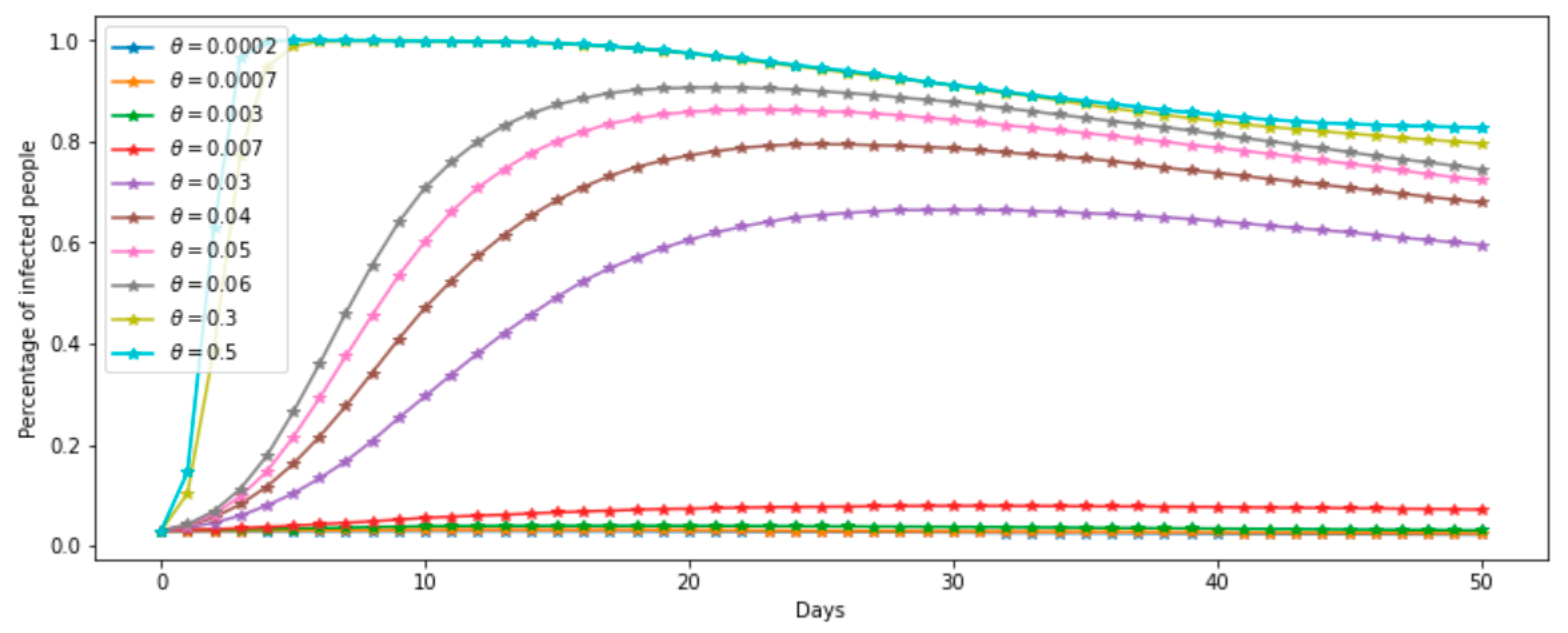
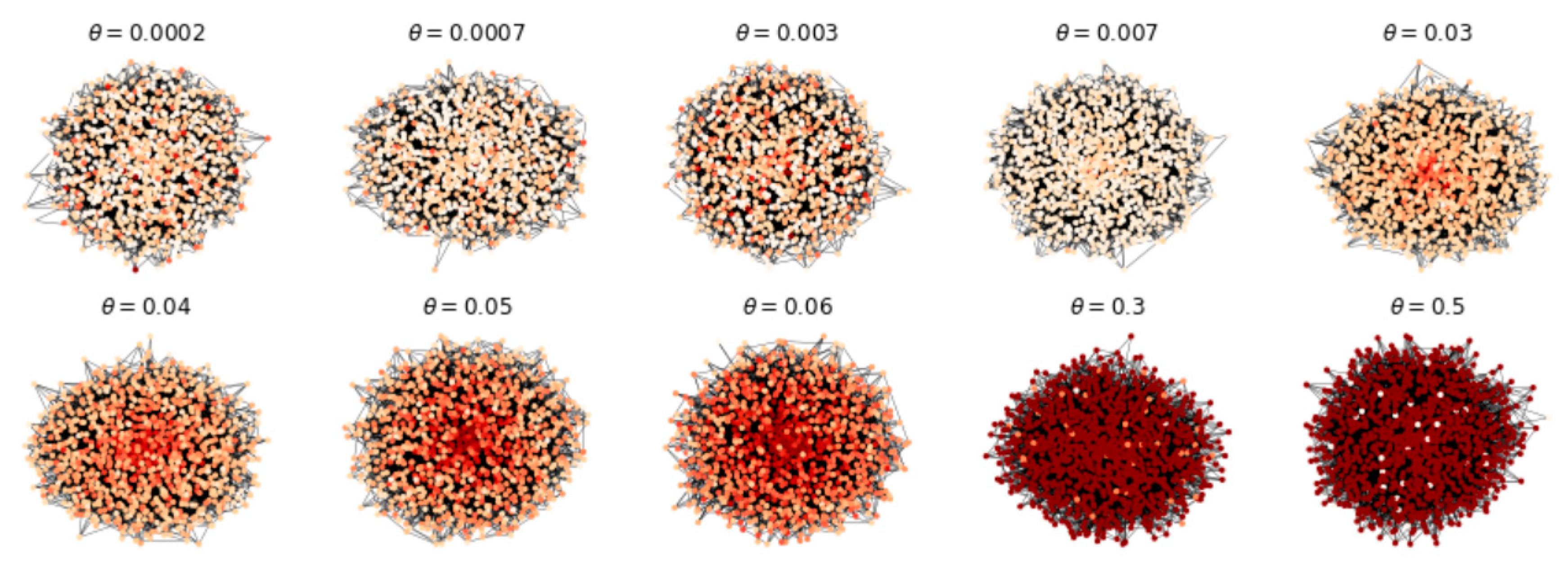
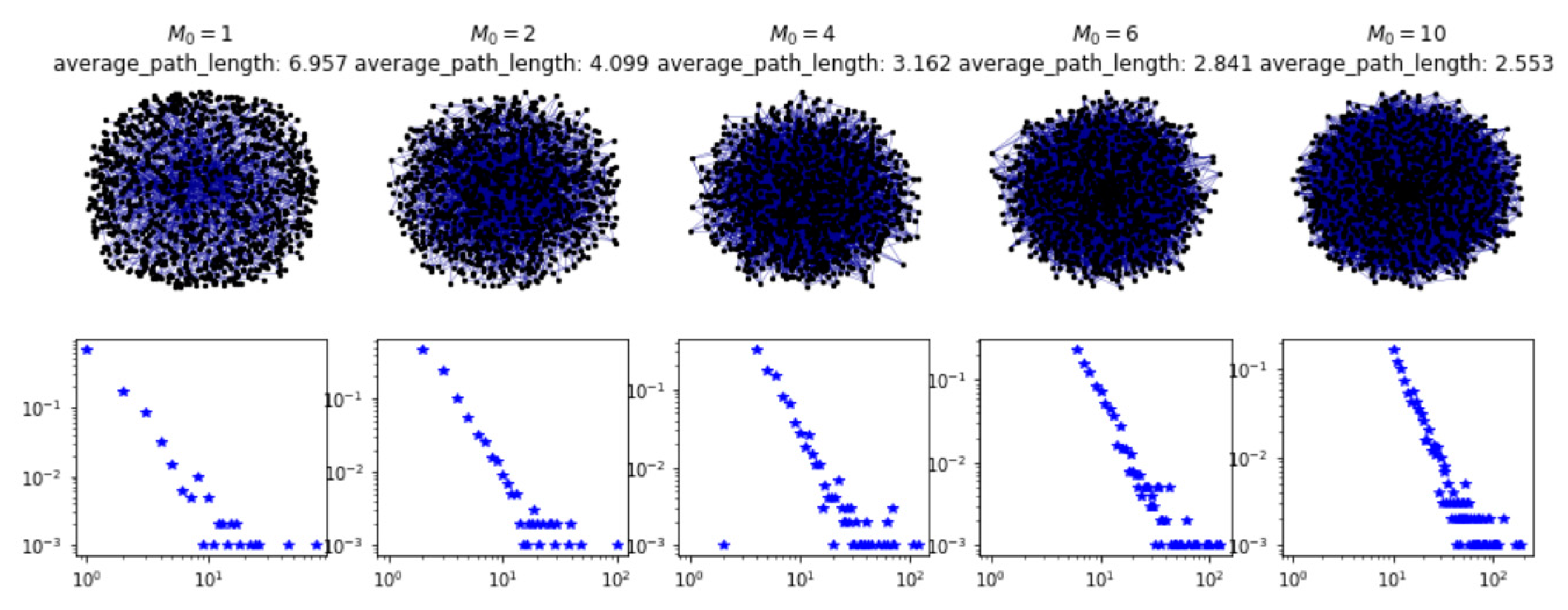


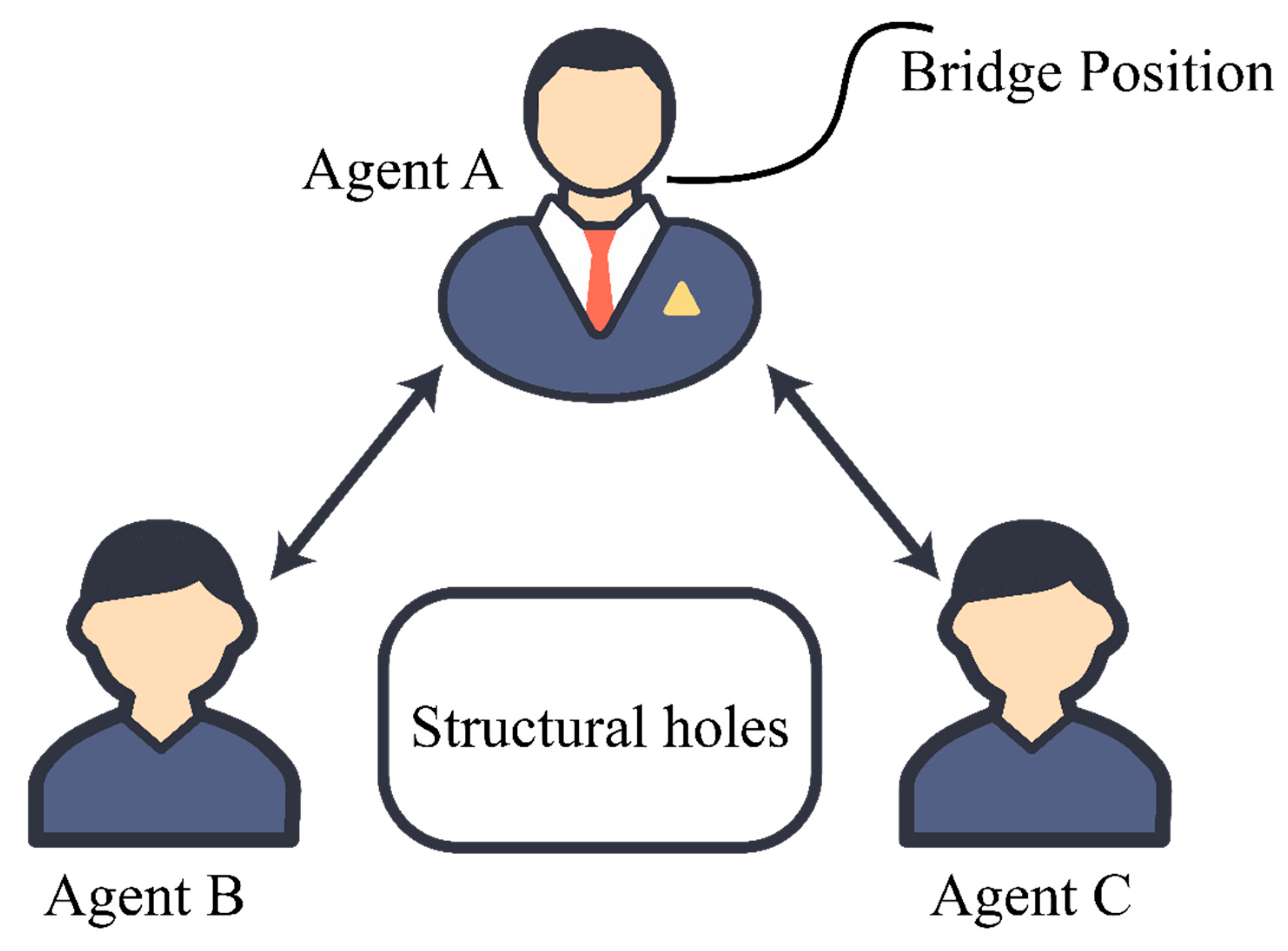
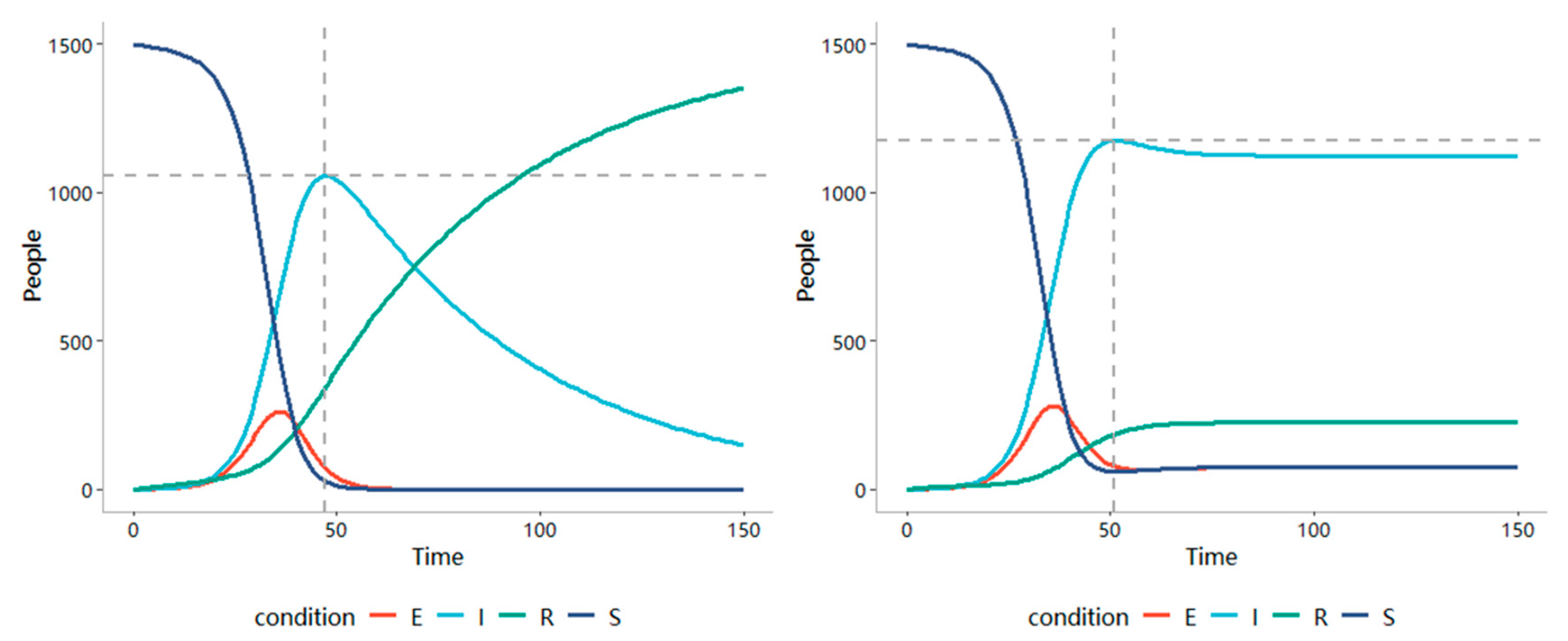
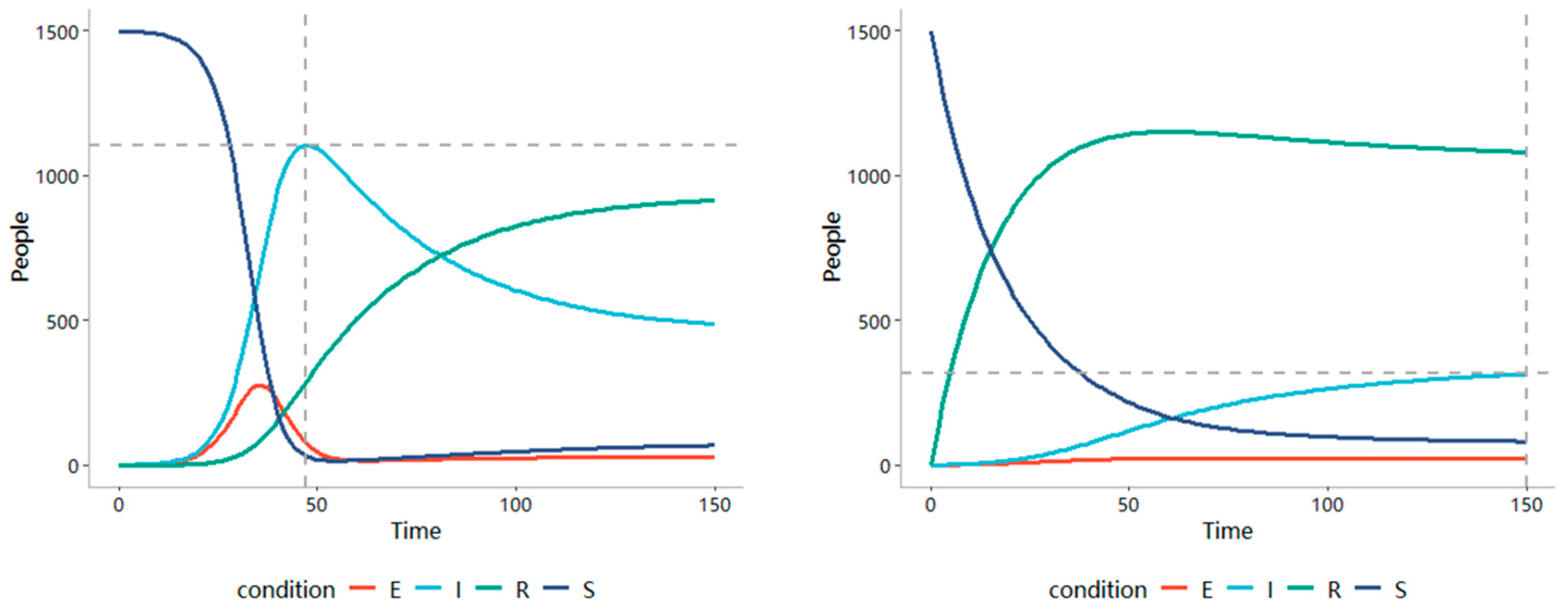
| SEIRS Model | Parameter Description | Meaning in the CLPP Dissemination |
|---|---|---|
| Virus | CLPP | CLPP that needs to be disseminated |
| Suspected (S) | Potential CLPP recipients | Farmers who have not yet accepted CLPP, but have the potential to accept |
| Exposed (E) | Potential disseminators of CLPP | Farmers who have been exposed to CLPP, but have not yet conducted policy dissemination |
| Infected (I) | CLPP disseminators | Farmers who have accepted the CLPP and conducted policy dissemination |
| Recovered (R) | Rejector of CLPP dissemination | Farmers who refuse to disseminate the policy after accepting the CLPP |
| Dissemination rate | Probably of changing from to | |
| Prevalence | Probably of changing from to | |
| Recovery rate | Probably of changing from to | |
| Vaccination rate | Probably of directly changing from to | |
| Immune degradation rate | Probably of directly changing from to |
Publisher’s Note: MDPI stays neutral with regard to jurisdictional claims in published maps and institutional affiliations. |
© 2021 by the authors. Licensee MDPI, Basel, Switzerland. This article is an open access article distributed under the terms and conditions of the Creative Commons Attribution (CC BY) license (http://creativecommons.org/licenses/by/4.0/).
Share and Cite
Lu, X.; Zhang, Y.; Tang, H. Modeling and Simulation of Dissemination of Cultivated Land Protection Policies in China. Land 2021, 10, 160. https://doi.org/10.3390/land10020160
Lu X, Zhang Y, Tang H. Modeling and Simulation of Dissemination of Cultivated Land Protection Policies in China. Land. 2021; 10(2):160. https://doi.org/10.3390/land10020160
Chicago/Turabian StyleLu, Xinhai, Yanwei Zhang, and Handong Tang. 2021. "Modeling and Simulation of Dissemination of Cultivated Land Protection Policies in China" Land 10, no. 2: 160. https://doi.org/10.3390/land10020160
APA StyleLu, X., Zhang, Y., & Tang, H. (2021). Modeling and Simulation of Dissemination of Cultivated Land Protection Policies in China. Land, 10(2), 160. https://doi.org/10.3390/land10020160







